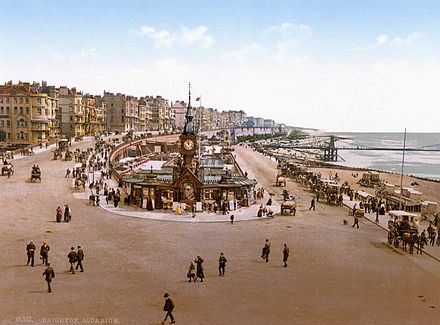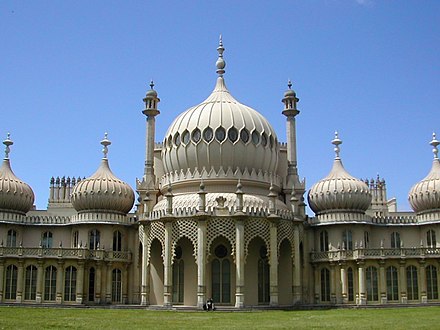Royal Suspension Chain Pier
This article needs additional citations for verification. (April 2012) |
 A postcard of the pier | |
| Spans | English Channel |
|---|---|
| Locale | Brighton, England |
| Owner | Marine Palace & Pier Company (from 1889) |
| Operator | Brightelmston Suspension Pier Company |
| Characteristics | |
| Total length | 1,134 feet (346 m) |
| Width | 13 feet (4.0 m) |
| History | |
| Designer | Samuel Brown |
| Construction start | 18 September 1822 |
| Completion date | September 1823 |
| Opening date | 25 November 1823 |
| Closure date | October 1896 |
| Destruction date | 4 December 1896 |
| Coordinates | 50°49′06″N 0°07′51″W / 50.81833°N 0.13083°W / 50.81833; -0.13083 |

The Royal Suspension Chain Pier was the first major pier built in Brighton, England. Opened on 25 November 1823, it was destroyed during a storm on 4 December 1896.[1]
History
Generally known as the Chain Pier, it was designed by Captain Samuel Brown rn,[2] with construction starting on 18 September 1822 and completing in September 1823,[3] opening on 25 November 1823.[4] Brown had completed the Trinity Chain Pier in Edinburgh in 1821.[5] The pier was primarily intended as a landing stage for packet boats to Dieppe, France, but it also featured a small number of attractions including a camera obscura. An esplanade with an entrance toll-booth controlled access to the pier which was roughly in line with the New Steine. Turner and Constable both made paintings of the pier, King William IV landed on it, and it was even the subject of a song.
The Chain Pier co-existed with the later West Pier, but a condition to build the Palace Pier was that the builders would dismantle the Chain Pier. They were saved this task by a storm that destroyed the already-closed and decrepit pier on 4 December 1896. Some of the debris from the pier damaged the then under-construction Palace Pier and the Daddy Longlegs railway.[6]
The remains of some of the pier's oak piles could be seen at low tides around 2010, however, as of 2021, they are no longer visible. Masonry blocks can still be seen. The signal cannon of the pier is still intact, as are the entrance kiosks which are now used as small shops on the Palace Pier.
Gallery
-
A photochrom of Brighton Aquarium with the pier in the background, originally photographed around 1890
-
Brighton beach with the Chain Pier in the background. By John Constable c.1824
-
The Chain Pier at Brighton, by J. M. W. Turner
-
Signal cannon from the Chain Pier, on Palace Pier
-
Model of the Royal Suspension Chain Pier on display at Brighton Museum & Art Gallery
See also
References
- ^ "Sussex Piers - East Sussex - West Sussex - Ports, Piers - Ferry Photographs - Ferry Postcards". www.simplonpc.co.uk. Retrieved 15 June 2017.
- ^ Drewry, Charles Stewart (1832). A Memoir of Suspension Bridges: Comprising The History Of Their Origin And Progress. London: Longman, Rees, Orme, Brown, Green & Longman. pp. 69–74, Plate V. Retrieved 13 June 2009.
- ^ "Completed in January 1823".
- ^ "Brighton Chain Pier - National Piers Society". 28 March 2016.
- ^ Skempton, A. W. (2002). A Biographical Dictionary of Civil Engineers in Great Britain and Ireland: 1500–1830. Thomas Telford. pp. 86–87. ISBN 978-0-7277-2939-2.
- ^ "The storied history of Brighton's long-lost third pier". 3 July 2022.
External links
 Media related to Royal Suspension Chain Pier at Wikimedia Commons
Media related to Royal Suspension Chain Pier at Wikimedia Commons- Pictures and Drawings of the pier - from "Science and Society Picture Library"
- Photographs of the pier
- My Brighton and Hove resources related to the pier
- thisbrighton.co.uk - Brighton's Piers History
- Brighton Chain Pier and Remains (flickr gallery)







.jpg/440px-26–37_Regency_Square,_Brighton_(IoE_Code_481129).jpg)


.jpg/440px-Hove_Club,_28_Fourth_Street,_Hove_(IoE_Code_365527).jpg)

